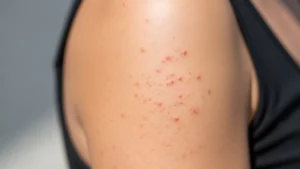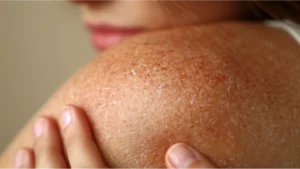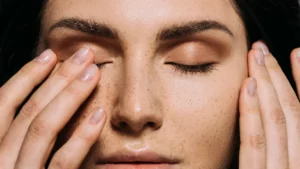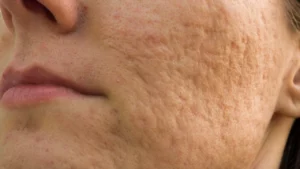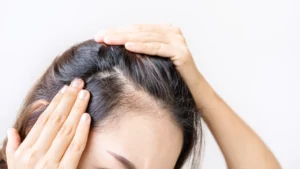Table of Contents
Keloids are tough, raised scars that grow bigger than the original wound. They are thick, often itchy, and can be painful. These scars form when your body makes too much collagen while healing. Unlike regular scars, keloids can keep growing even after the wound has healed.
People with darker skin tones are more likely to get keloids. This includes people with Fitzpatrick skin types IV to VI. If you have keloid-prone skin, you might notice these thick scars after cuts, burns, piercings, or even acne.
Here’s some good news: doctors are now using Botox to help prevent keloids and make existing ones smaller. This treatment might be the answer you’ve been looking for if you struggle with keloid scars.
Why Some Skin Is More Prone to Keloids
Genetics Play a Major Role –
Not everyone gets keloids. If keloids run in your family, you’re at higher risk.
Skin Tone and Keloid Risk –
People with Fitzpatrick skin types IV-VI (medium to dark skin) have a 5-15% higher chance of developing keloids.
High-Risk Body Areas:
- Chest and shoulders
- Upper back
- Jawline and ears
- Areas that move a lot
Common Keloid Triggers:
- Acne scars, especially deep cysts
- Ear piercings
- Surgical cuts
- Tattoos
- Burns or cuts
- Chickenpox scars
Botox as a Keloid Prevention Tool
Botox isn’t just for wrinkles anymore. Botox works by inhibiting the release of acetylcholine, which relaxes the muscles and decreases tension at the wound edges, reducing the risk of abnormal collagen deposition.
Here’s how Botox helps prevent keloids:
Reduces Muscle Tension:
Botox relaxes the muscles around a wound. This means less pulling and stretching of the healing skin.
Controls Collagen Production:
There is evidence in the literature to suggest that BoNT-A can inhibit the production of collagen and limit hypertrophy of the wound.
Prevents Keloid Return:
After keloid removal surgery, Botox can help prevent the keloid from coming back. This is especially important because keloids often return after surgical removal.
Can Botox Shrink or Flatten Existing Keloids?
The short answer is yes, but it’s not magic. Botulinum toxin appears to be equivalent to triamcinolone in producing a short-term reduction in keloidal volume, height and vascularity.
For existing keloids, Botox can:
- Make them flatter
- Reduce their size
- Make them less red or purple
- Reduce pain and itching
But here’s the important part: Botox works best when combined with other treatments. It also inhibits the growth of the keloid by modulation collagen deposition and inflammatory cytokines.
Your doctor might combine Botox with:
- Steroid injections
- Laser treatments
- Microneedling
- Silicone sheets
Don’t expect Botox alone to make a large keloid disappear, but it can definitely help make it smaller and less noticeable.
When and How Is Botox for Keloids Administered?
The timing of Botox treatment is very important. This might be after:
- Mole removal
- Acne treatment for deep cysts
- Ear piercing
- Any surgical procedure
The process is simple and quick. Your doctor will inject small amounts of Botox around the wound or scar area. The needle is very fine, so most people find it comfortable.
How Much Botox Is Used: The amount depends on the size and location of the area. It’s usually much less than what’s used for wrinkles.
How Often: This therapy is done every 4 weeks until the size of the keloid has significantly reduced. This usually takes about 6 to 8 treatments on average.
Safety: Botox for keloids is very safe when done by a trained doctor. The doses used are small, and side effects are rare.
The treatment works gradually. You won’t see changes overnight, but over several weeks, you should notice the keloid getting flatter and softer.
Is Botox Right for Your Skin Type and Scar History?
If you have keloid-prone skin, Botox might be perfect for you. It’s especially helpful if you:
- Have had keloids before
- Are planning surgery or a cosmetic procedure
- Have family members with keloids
- Have darker skin that scars easily
The good news is that Botox is safe for all skin colors. Unlike some treatments that can cause dark spots in brown or black skin, Botox doesn’t affect your skin color.
Who Should Consider Botox for Keloids:
- People getting mole removal
- Those with acne scars
- Anyone having surgery in keloid-prone areas
- People with existing keloids that haven’t responded to other treatments
Important Considerations:
- You need to start early for prevention
- Multiple sessions work better than one
- It should be done by an experienced doctor
- Results vary from person to person
At Isya Aesthetics, we understand that every person’s skin is different. Dr. Kiran Sethi creates personalized treatment plans based on your skin type, scar history, and individual needs.
Why Choose Isya Aesthetics for Keloid Prevention
Dr. Kiran Sethi at Isya Aesthetics brings years of experience in treating keloid-prone skin. She understands the unique challenges that come with scars in darker skin tones and has helped hundreds of patients prevent and treat keloids.
- Expert Knowledge: Deep understanding of how different skin types heal
- Safe Techniques: Proven methods that work for all skin colors
- Personalized Care: Every treatment plan is made just for you
- Advanced Technology: We use the latest techniques and equipment
- Patient Education: We teach you how to care for your skin at home
Our Approach: We don’t just treat keloids – we help prevent them. Whether you’re planning a procedure or already have keloids, we create a plan that fits your needs. We might combine Botox with other treatments for the best results.
At Isya Aesthetics, we typically use Botox for existing keloids rather than just prevention, although we can provide preventive treatment when needed. Our focus is on helping you achieve the best possible results for your unique skin.
Conclusion
Botox for keloids isn’t a miracle cure, but it’s a powerful tool in the fight against problematic scars. The key is early action and expert care. Whether you want to prevent keloids after surgery or shrink existing ones, Botox can be part of your solution.
The most important thing to remember is that keloid treatment works best when you start early and work with an experienced doctor. Don’t wait until keloids become a bigger problem.
If you’re keloid-prone or already struggling with thick, raised scars, now is the time to take action. With the right treatment plan, you can take control of your skin’s healing process.
Struggling with keloids or want to prevent them after surgery or acne? Discover how Botox can be part of your scar-prevention plan. Book your expert consultation with Dr. Kiran Sethi at Isya Aesthetics today!


